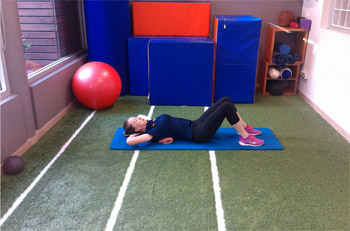Five Stretches Every Pregnant Woman Should Be Doing

Five Stretches Every Pregnant Woman Should Be Doing
It's a common misconception that when a woman falls pregnant she should put her feet up and relax for nine months. Kate Faber, Accredited Exercise Physiologist from Precision Physio explains that in fact it is quite the opposite.
During pregnancy women are told lots of things they should avoid – things they can't eat, products they shouldn't use and positions they shouldn't get in to. Exercise during pregnancy is not one of those things (unless advised by your GP or Obstetrician).
Kate advises, 'On finding out you're pregnant you should speak to your doctor or midwife about your current level of exercise, and what is safe for you to do during your pregnancy. What you may not be aware of is that these days most women are actually encouraged to get in to exercise during their pregnancy, even if they weren't active prior to conception.
'Exercise has been shown to have many benefits for both mum and bub during pregnancy, providing it is the right type, at the right stage. Benefits include reducing the risk of gestational diabetes, hypertension and pre‐eclampsia, assisting in the management of symptoms associated with pregnancy such as back pain, pelvic pain and fatigue; and helping with mental well-being, and recovery from labour and delivery."
Kate's top five stretches for pregnant women:
1. Cat & Camel Stretch: To warm up the joints of your spine. How: On all fours, breathe in as you look forward and point your tailbone to the ceiling, then breathe out as you look to your belly button and point your tailbone to the floor. Move gently back and forth between the two positions, and only move through your comfortable range. Aim to create a smooth curve of the spine in both directions. 5--‐10 repetitions in each direction.
2. Forward Kneeling Stretch (with or without a Swiss ball) : To stretch your lower and upper back, and pelvic floor muscles. How: Sit on your heels, with your feet together, and your knees apart. Reach forward to either place your hands on the ground, or on a Swiss ball. Let your head and neck relax, as your breathe deeply. Hold for 5--‐10 deep breaths.
3. Thoracic Opener: To allow extension of the joints of the upper back which are often 'stuck" in a flexed or 'hunch" position, particularly during later stages of pregnancy. How: Roll a full size towel into a log shape. Place the towel on the floor, and lie back over it, so that the log runs across your upper back, approximately at the level of your bra strap. If this stretch is feeling strong, then support your head in your hands as you lower yourself back only as far as you are comfortable. If you're at this stage, then hold for a breath or two only, and repeat with a break in between.
4. Thread the Needle: To allow rotation of the joints of the upper and lower back. How: On all fours, breathe in as you take your right hand and reach it up to the ceiling, looking towards your right hand. Breathe out as you then reach your right hand into the space created between your left hand and left knee. Then, breathe in as you take your left hand and reach it up to the ceiling, looking towards your left hand. Breathe out as you then reach your left hand into the space created between your right hand and right knee. The idea is to make your arm as long as possible to get the most out of the stretch. 5--‐10 repetitions in each direction.
5. Side Stretch: To stretch the small muscles in between the ribs and the muscles on the sides of your abdomen. How: Stand tall, interlock fingers and press hands overhead towards the ceiling (palms up). Breathe in, and as your breathe out, push your right hand even further away as you bend to your left side (you should feel a stretch down the right side of your body). Breathe in as you come back to centre, and breath out as you push your left hand away and bend to your right side (now you should feel a stretch down the left side of your body). 5--‐10 repetitions in each direction.
'At all times, but particularly during pregnancy, you should only ever perform a stretch or exercise which is at most uncomfortable – it should never be painful! Move through a range which is comfortable for you, regardless of what anyone else around you may be capable of, or how far you think the stretch is -meant' to go. During pregnancy, many women will find they are more mobile, as more of the hormone relaxin is produced, increasing the laxity of your joints. So take your time with the stretches – there's no need to rush!" said Kate.
www.precisonphysio.com.au
MORE



